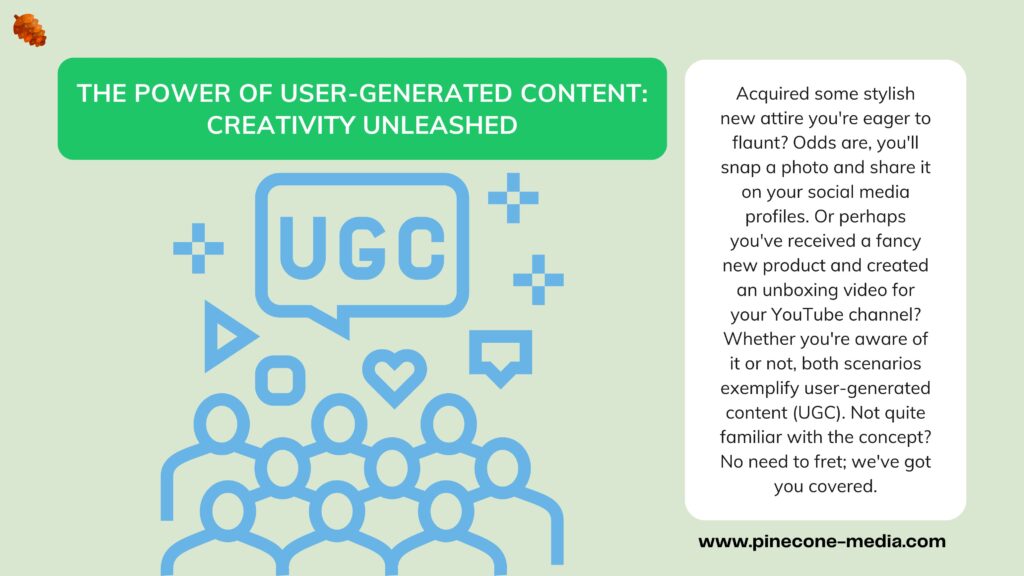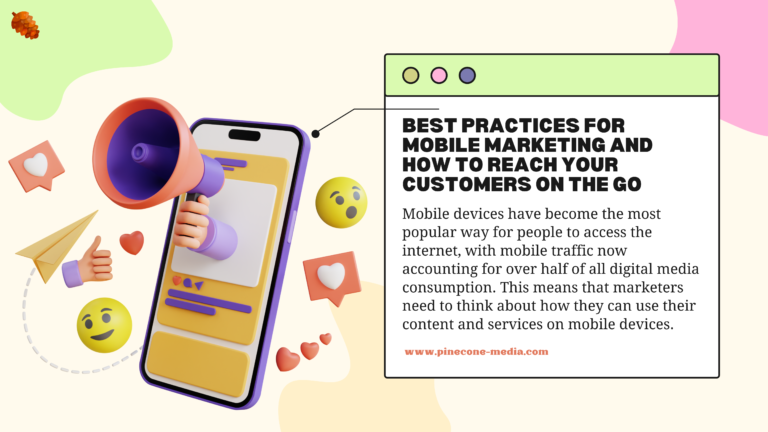Acquired some stylish new attire you’re eager to flaunt? Odds are, you’ll snap a photo and share it on your social media profiles. Or perhaps you’ve received a fancy new product and created an unboxing video for your YouTube channel? Whether you’re aware of it or not, both scenarios exemplify user-generated content (UGC). Not quite familiar with the concept? No need to fret; we’ve got you covered.

What exactly is user-generated content?
User-generated content, often abbreviated as UGC or consumer-generated content, refers to unique, brand-specific content produced by consumers and shared on platforms like social media. UGC takes various shapes, such as images, videos, reviews, testimonials, or even podcasts.
Where does UGC content originate from?
- Customers– Consider unboxing videos shared on TikTok or enthusiastic posts on Instagram. Typically, your customers are the primary source of UGC, either because you’ve encouraged them to share or because they’ve chosen to do so organically.
- Brand Enthusiasts– These dedicated customers, also known as advocates or fans, are extremely passionate about your brand. Given their enthusiasm, they are an ideal group to approach for specific UGC content.
- Team Members– Employee-generated content (EGC) provides insight into your brand’s value and story. For instance, photos of employees packing orders or a video featuring your team discussing their love for the company. This behind-the-scenes content helps shape your brand identity and is effective across social media and ads, showcasing authenticity.
- UGC Creators– A UGC creator is an individual who produces sponsored content that appears genuine but is crafted to highlight a particular business or product. These creators are not generating traditional organic UGC; instead, they are compensated by brands to craft content that mimics traditional UGC.
Why is user-generated content important?
User-generated content (UGC) is immensely important in today’s digital landscape for several compelling reasons. Firstly, it fosters authenticity and trust. Unlike traditional advertising and brand-generated content, UGC is created by real customers and users. When potential consumers see authentic reviews, images, or videos from their peers, they are more likely to trust the information and form positive opinions about a product or service. This leads to increased credibility for the brand.
Secondly, UGC is a powerful tool for engagement. It encourages customers to interact with the brand, whether by leaving reviews, sharing photos on social media, or participating in contests. This engagement not only deepens their connection with the brand but also extends its reach as their UGC is shared with their own networks. This organic sharing can result in a viral effect, significantly expanding the brand’s visibility.
Moreover, UGC provides valuable insights. By analyzing the content created by users, brands can gain a better understanding of their customers’ preferences, pain points, and behaviors. This information is invaluable for refining products, enhancing customer experiences, and developing more effective marketing strategies.
UGC is also cost-effective. While creating high-quality content can be expensive and time-consuming, UGC is often generated voluntarily by customers. Brands can leverage this content without incurring substantial production costs, making it a budget-friendly marketing strategy.
Additionally, UGC enhances the sense of community around a brand. When customers see others sharing their experiences and opinions, they feel like part of a larger community of like-minded individuals. This sense of belonging can lead to increased brand loyalty and repeat business.
In summary, user-generated content is important because it builds trust, drives engagement, offers insights, is cost-effective, and fosters a sense of community. By harnessing the power of UGC, brands can create more authentic, effective, and customer-centric marketing campaigns in an increasingly competitive digital landscape.
User-generated content (UGC) encompasses a diverse range of content types, reflecting the creativity and engagement of users across various digital platforms. One of the most common forms is customer reviews and testimonials, where individuals share their experiences and opinions about products or services. Visual UGC, such as photos and videos posted on social media, provides a dynamic way for users to express themselves and showcase products in real-life contexts. Unboxing videos, in particular, have gained popularity as consumers share their excitement about new purchases. UGC also extends to written content, including blog posts, forum discussions, and comments on websites, offering valuable insights and perspectives. Collaborative content, where users contribute to a collective project or idea, is another form, often seen in wikis and crowd-sourced content. Ultimately, UGC spans a broad spectrum of content types, reflecting the rich tapestry of user-generated contributions in the digital age.
Some of the best user-generated content examples showcase the power of authentic, engaging content created by customers, brand enthusiasts, and the general public. Here are a few notable examples:
- GoPro’s User-Generated Adventure Videos: GoPro encourages its users to share their thrilling adventure videos filmed with GoPro cameras. The company curates and shares some of the best submissions on its website and social media channels, creating an exciting community of adventure enthusiasts.
- Starbucks’ #RedCupContest: Starbucks launched the #RedCupContest, encouraging customers to share their creative designs on the iconic red holiday cups. This UGC campaign not only generates excitement but also fosters a sense of community and holiday spirit.
- Coca-Cola’s “Share a Coke” Campaign: Coca-Cola’s “Share a Coke” campaign featured personalized bottles with popular names. Customers were encouraged to find and share bottles with their names on social media. This campaign led to a massive wave of UGC and significantly increased brand engagement.
- Airbnb’s Instagram Campaign: Airbnb’s Instagram account features stunning photos of unique listings and destinations shared by hosts and guests. These images offer a genuine glimpse into the Airbnb experience and inspire others to book accommodations through the platform.
- Lululemon’s #TheSweatLife: Lululemon’s #TheSweatLife campaign encourages customers to share their fitness journey and experiences with Lululemon products. It not only builds a sense of community but also showcases the versatility and quality of their athletic wear.
- LEGO’s Ideas Platform: LEGO’s Ideas platform allows fans to submit their own LEGO set designs. When a design receives enough support, LEGO may produce and sell it as an official set. This not only engages the fan community but also fuels innovation.
These examples illustrate how user-generated content can enhance brand engagement, foster a sense of community, and promote products or experiences authentically.
User-generated content tips
- Create Clear Guidelines: Establish clear guidelines and encourage your customers to create content that aligns with your brand’s values and messaging. These guidelines should cover aspects like content quality, appropriate language, and any specific themes or topics you want to highlight. Providing examples or templates can also be helpful to guide your customers in creating content that resonates with your brand.
- Leverage Hashtags and Campaigns: Develop branded hashtags or campaigns to encourage user-generated content sharing. Make these hashtags easy to remember and use across various social media platforms. Promote these campaigns through your marketing channels and consider offering incentives, such as giveaways or contests, to motivate customers to participate. Keep the campaign focused and aligned with your brand’s objectives.
- Engage and Reward Contributors: Show appreciation for your customers’ contributions by acknowledging and rewarding their efforts. Engage with user-generated content by liking, sharing, or commenting on it. Consider spotlighting exceptional user-generated content on your website, social media, or marketing materials. Offering rewards or recognition to top contributors, such as featuring their content prominently or providing exclusive discounts, can further incentivize UGC creation.
By implementing these tips, you can foster a thriving community of brand advocates and generate valuable user-generated content that strengthens your brand’s online presence and credibility.
In conclusion, user-generated content (UGC) is a potent force in the world of digital marketing and brand promotion. Its authenticity, relatability, and reach make it a valuable asset for businesses aiming to connect with their audience on a deeper level. By understanding what UGC is and where it comes from, as well as exploring its various forms and examples, you can unlock its full potential. Moreover, following best practices such as clear guidelines, engaging campaigns, and rewarding contributors can help you harness the power of UGC to build stronger brand loyalty, enhance your online presence, and drive meaningful engagement with your audience. As you embark on your UGC journey, remember that your customers are your most powerful advocates, and their voices, stories, and experiences can be the driving force behind your brand’s success in the digital age.




